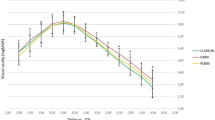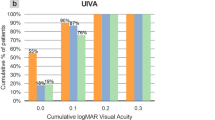Abstract
Purpose
The aim of the current study was to compare the quality of vision, contrast sensitivity and patient satisfaction with a biaspheric, segmented, rotationally asymmetric IOL (Lentis Comfort LS-313 MF 15-Oculentis GmbH, Berlin, Germany) as opposed to those of a monofocal IOL.
Methods
This prospective single-blind comparative study included two groups of patients affected by bilateral senile cataract who underwent lens extraction and IOL implantation. The first group received a bilateral implantation of a monofocal IOL, and the second group received a bilateral implantation of the Comfort IOL. Twelve months after surgery uncorrected and corrected visual acuity at different distances (30, 50, 70 cm and 4 m), defocus curve and contrast sensitivity were assessed. Patient’s satisfaction and spectacle independence were evaluated by mean of the NEI RQL-42 questionnaire.
Results
No significant differences were found between the groups in terms of near vision. The group of patients implanted with a Comfort IOL obtained the best results at intermediate distances (50 and 70 cm P < .001). Both groups showed an excellent uncorrected distance visual acuity (4 m). No statistically significant differences were found in terms of corrected near, intermediate and distance visual acuity. Concerning contrast sensitivity, no statistically significant differences between the groups were observed at any cycles per degree. The NEI RQL-42 questionnaire showed statistically significant differences between the group for “near vision” (P = .015), “dependence on correction” (P = .048) and “suboptimal correction” (P < .001) subscales.
Conclusion
Our findings indicated that the Comfort IOL +1.5 D provides a good intermediate spectacle independence together with a high quality of vision, with a low amount of subjective symptoms and a contrast sensitivity similar to those obtained with a monofocal IOL.



Similar content being viewed by others
References
Pieh S, Lackner B, Hanselmayer G, Zöhrer R, Sticker M, Weghaupt H, Fercher A, Skorpik C (2001) Halo size under distance and near conditions in refractive multifocal intraocular lenses. Br J Ophthalmol 85(7):816–821
Muñoz G, Albarrán-Diego C, Ferrer-Blasco T, Sakla HF, García-Lázaro S (2011) Visual function after bilateral implantation of a new zonal refractive aspheric multifocal intraocular lens. J Cataract Refract Surg 37(11):2043–2052
Souza CE, Muccioli C, Soriano ES, Chalita MR, Oliveira F, Freitas LL, Meire LP, Tamaki C, Belfort R Jr (2006) Visual performance of AcrySof ReSTOR apodized diffractive IOL: a prospective comparative trial. Am J Ophthalmol 141(5):827–832
Souza CE, Gerente VM, Chalita MR, Soriano ES, Freitas LL, Belfort R Jr (2006) Visual acuity, contrast sensitivity, reading speed, and wavefront analysis: pseudophakic eye with multifocal IOL (ReSTOR) versus fellow phakic eye in non-presbyopic patients. J Refract Surg 22(3):303–305
Alió JL, Piñero DP, Plaza-Puche AB, Chan MJ (2011) Visual outcomes and optical performance of a monofocal intraocular lens and a new-generation multifocal intraocular lens. J Cataract Refract Surg 37(2):241–250
Alio JL, Plaza-Puche AB, Javaloy J, Ayala MJ, Moreno LJ, Piñero DP (2012) Comparison of a new refractive multifocal intraocular lens with an inferior segmental near add and a diffractive multifocal intraocular lens. Ophthalmology 119(3):555–563
Alió JL, Plaza-Puche AB, Javaloy J, Ayala MJ (2012) Comparison of the visual and intraocular optical performance of a refractive multifocal IOL with rotational asymmetry and an apodized diffractive multifocal IOL. J Refract Surg 28(2):100–105
Pepose JS, Qazi MA, Davies J, Doane JF, Loden JC, Sivalingham V, Mahmoud AM (2007) Visual performance of patients with bilateral vs combination Crystalens, ReZoom, and ReSTOR intraocular lens implants. Am J Ophthalmol 144(3):347–357
Rocha KM, Chalita MR, Souza CE, Soriano ES, Freitas LL, Muccioli C, Belfort R Jr (2005) Postoperative wavefront analysis and contrast sensitivity of a multifocal apodized diffractive IOL (ReSTOR) and three monofocal IOLs. J Refract Surg 21(6):S808–S812
Schmitz S, Dick HB, Krummenauer F, Schwenn O, Krist R (2000) Contrast sensitivity and glare disability by halogen light after monofocal and multifocal lens implantation. Br J Ophthalmol 84:1109–1112
Blaylock JF, Si Z, Aitchison S, Prescott C (2008) Visual function and change in quality of life after bilateral refractive lens exchange with the ReSTOR multifocal intraocular lens. J Refract Surg 24(3):265–273
Vingolo EM, Grenga P, Iacobelli L, Grenga R (2007) Visual acuity and contrast sensitivity: AcrySof ReSTOR apodized diffractive versus AcrySof SA60AT monofocal intraocular lenses. J Cataract Refract Surg 33(7):1244–1247
Bartholomeeusen E, Rozema J, Tassignon MJ (2012) Outcome after multifocal intraocular lens exchange because of severely impaired quality of vision. Bull Soc Belge Ophtalmol 319:43–50
McGwin G Jr, Scilley K, Brown J, Owsley C (2003) Impact of cataract surgery on self-reported visual difficulties: comparison with a no-surgery reference group. J Cataract Refract Surg 29:941–948
Pedrotti E, Mastropasqua R, Passilongo M, Parisi G, Marchesoni I, Marchini G (2014) Comparison of two multifocal intraocular lens designs that differ only in near add. J Refract Surg 30(11):754–760
Alio Jorge L, Plaza-Puche Ana B, Montalban Raul, Javaloy Jaime (2012) Visual outcomes with a single-optic accommodating intraocular lens and a low-addition-power rotational asymmetric multifocal intraocular lens. J Cataract Refract Surg 38:978–985
Owsley C, McGwin G Jr, Scilley K, Meek GC, Seker D, Dyer A (2007) Impact of cataract surgery on health-related quality of life in nursing home residents. Br J Ophthalmol 91:1359–1363
Mastropasqua Rodolfo, Pedrotti Emilio, Passilongo Mattia, Parisi Graziella, Marchesoni Ivan, Marchini Giorgio (2015) Long-term visual function and patient satisfaction after bilateral implantation and combination of two similar multifocal IOLs. J Refract Surg 31(5):308–314
Alfonso JF, Fernández-Vega L, Puchades C, Montés-Micó R (2010) Intermediate visual function with different multifocal intraocular lens models. J Cataract Refract Surg 36:733–739
Maxwell WA, Cionni RJ, Lehmann RP, Modi SS (2009) Functional outcomes after bilateral implantation of apodized diffractive aspheric acrylic intraocular lenses with a +3.0 or +4.0 diopter addition power: randomized multicenter clinical study. J Cataract Refract Surg 35:2054–2061
Toto L, Carpineto P, Falconio G, Agnifili L, Di Nicola M, Mastropasqua A, Mastropasqua L (2013) Comparative study of Acrysof ReSTOR multifocal intraocularnlenses +4.00 D and +3.00 D: visual performance and wavefront error. Clin Exp Optom 96:295–302
Ruiz-Mesa R, Abengózar-Vela A, Aramburu A, Ruiz-Santos M (2017) Comparison of visual outcomes after bilateral implantation of extended range of vision and trifocal intraocular lenses. Eur J Ophthalmol. doi:10.5301/ejo.5000935
Gatinel G, Loicq J (2016) Clinically relevant optical properties of bifocal, trifocal and extended depth of focus intraocular lenses. J Refract Surg 32:273–280
Author information
Authors and Affiliations
Corresponding author
Ethics declarations
Conflict of interest
The authors declare that they have no conflict of interest.
Ethical approval
All procedures performed in studies involving human participants were in accordance with the ethical standards of the institutional and/or national research committee and with the 1964 Helsinki Declaration and its later amendments or comparable ethical standards.
Informed consent
Informed consent was obtained from all individual participants included in the study.
Rights and permissions
About this article
Cite this article
Pedrotti, E., Mastropasqua, R., Bonetto, J. et al. Quality of vision, patient satisfaction and long-term visual function after bilateral implantation of a low addition multifocal intraocular lens. Int Ophthalmol 38, 1709–1716 (2018). https://doi.org/10.1007/s10792-017-0652-x
Received:
Accepted:
Published:
Issue Date:
DOI: https://doi.org/10.1007/s10792-017-0652-x




